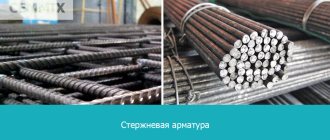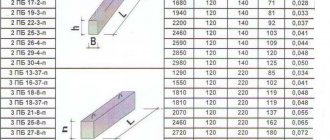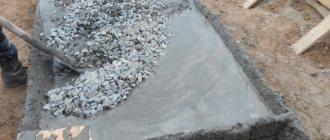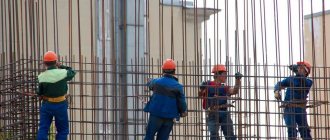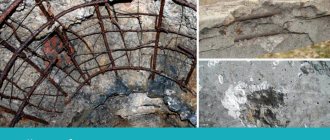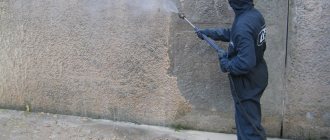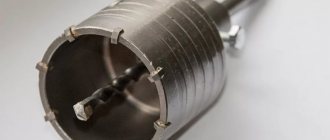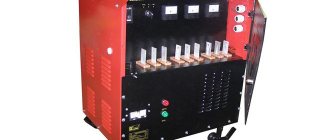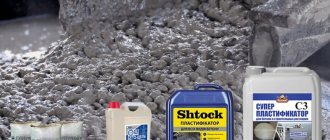Reinforced concrete is a special block of concrete mortar that has been additionally reinforced with foreign elements.
Concrete is a key building material used in construction since the times of Ancient Greece. But it is deformed under the influence of various factors. Therefore, to improve the strength characteristics, concrete is reinforced with metal elements:
- nets;
- synthetic fibers;
- fiberglass;
- geosynthetic materials;
- composite rods;
- fiber fiber;
- rods;
- become.
The reinforcement must be tensioned using chemical, electrothermal or mechanical methods.
Reinforcement of concrete is technologically simple and economically beneficial, since the consumption of concrete mixture is reduced. As a result, the thickness of the slab decreases.
Polypropylene fiber
Universal polypropylene reinforcing fiber for adding to the solution.
More details
There are two types of reinforced concrete structures:
- Prefabricated reinforced concrete structures – manufactured at a reinforced concrete structures plant;
- Monolithic reinforced concrete structures are manufactured directly on site at the construction site.
The meaning of reinforcement is that the load on the concrete is transferred to the reinforcement and is evenly distributed throughout the structure. The reinforcement is also responsible for the strength of the connection between the elements.
Calculation of reinforcement in the project, critical parameters
The number, diameters and location of reinforcement in structures is determined by the project, the calculation is carried out according to the limit states of reinforced concrete structures in accordance with regulatory technical documents (for example, designers use the “Manual for the design of concrete and reinforced concrete structures made of heavy concrete without prestressing reinforcement (to SP 52-101- 2003)")
Types of fittings and materials from which they are made
The fittings are divided into three types depending on their purpose.
Working fittings
Designed to absorb stresses arising from the influence of external loads, as well as from the structure itself.
Distribution fittings
Performs three tasks:
- distributes loads evenly between the working rods;
- ensures the joint operation of working reinforcement elements;
- prevents displacement of working reinforcement during concreting.
Mounting fittings
Serves to ensure the exact position of reinforcement elements inside the formwork.
Reinforcing products
The following types of products exist:
- grids;
- rods;
- frames, which can be flat or spatial;
- products for prestressed structures;
- mounting loops and clamps, embedded parts.
Steel reinforcement
Manufactured in accordance with GOST 5781-82. This standard applies to hot-rolled round steel of smooth and periodic profiles intended for the reinforcement of ordinary and prestressed reinforced concrete structures (reinforcing steel).
Steel reinforcement bars are made from round profile bars, which can have a smooth surface or a corrugated surface with projections (periodic profile).
Smooth reinforcement is considered ineffective due to weak adhesion to concrete, and therefore today is used mainly as an auxiliary one for clamps for securing corrugated reinforcement in the frame.
Periodic profile reinforcement, thanks to the protrusions, adheres more effectively to concrete. For reinforcement with a smooth surface, for these purposes it is necessary to bend the ends with a hook.
The most common type of reinforcement in civil and industrial construction is rod reinforcement with a cross-sectional diameter of 12–40 mm. Sometimes profiled metal can be used for reinforcement.
Reinforcing mesh
Welded reinforcing bars are made from rods with a cross-section of more than 3 mm or from reinforcing wire. They can be: flat (if the diameter of the transverse rods is 10 mm or more, and the longitudinal rods are 5 mm or more).
Meshes are manufactured with different reinforcement spacing, which is determined according to the project or standard design solution. The most common square cells are 100*100 mm, 150*150 mm, 200*200 mm, but other sizes are often used.
Factory-made meshes are made with a width of no more than 3500 mm, which is due to transportation requirements.
Rolled mesh can have different rod diameters, mesh sizes and mesh widths. The roll weight does not exceed 1200 kg.
Flat and spatial frames
Flat steel frames consist of belts formed by reinforcement and lattice connecting them. The cross-sectional diameter of the working fittings is 10–40 mm, distribution fittings – from 10 mm. They are used for various linear structures (ceilings, beams, crossbars).
How to determine the required amount of reinforcement
Figure 3. Reinforcement for concrete
To determine the required amount of reinforcement, it is necessary to take into account the type of foundation, as well as its shape. If you have a tiled foundation, then you must use metal rods with a diameter of at least 10 mm with stiffeners. In addition, the required diameter depends on the type of soil and the size of the future building. Rods with a diameter of 10 mm are suitable for light houses with stable soil. If the building has several floors, then it is best to use reinforcement from 15 mm.
To reinforce a 6 by 6 tiled foundation, it is necessary to erect a structure of metal rods with a maximum pitch of 20 centimeters. For such an area you will need 31 rods in each direction - that is, only 62 pieces. For reinforcement it is necessary to erect two belts. Thus, 124 rods will be required to process the entire foundation. If you calculate everything in meters, you get 744.
Polypropylene fiber
Universal polypropylene reinforcing fiber for adding to the solution.
More details
Spatial frames are used to reinforce columns, beams, and foundations.
Wire steel reinforcement for prestressed structures
Represents high-strength wire ropes or twisted strands of wire (three or more).
Non-metallic fittings
Non-metallic composite reinforcement - non-metallic rods made of glass, basalt, carbon or aramid fibers - is becoming increasingly common.
In this case you receive:
- glass-reinforced concrete, which is characterized by high strength and reduced water and gas permeability;
- high strength and impermeable basalt concrete.
The advantages of concrete reinforced with composite materials include the following characteristics:
- the strength and durability of the structure increases;
- the risk of cracks in concrete is significantly reduced;
- it becomes possible to produce concrete products of almost any shape;
- reinforcement increases the tensile and bending strength of concrete;
- resistance to temperature changes increases;
- volumetric reinforcement increases the impact strength of concrete and reduces its abrasion;
- the use of volumetric fiber reinforcement makes it possible to reduce the thickness of the screeds while maintaining their load-bearing capabilities.
Thus, reinforced concrete has many important advantages compared to non-reinforced concrete: it is stronger, more durable in use, and more resistant to adverse external factors. But it also has certain disadvantages that also need to be taken into account:
- reinforcement is possible only at the construction stage, so its necessity is laid down at the design stage;
- steel reinforcement increases the weight of the structure by an average of 150–200 kg for every cubic meter of concrete;
- reinforcement with mesh or steel rod reinforcement is a serious financial cost, in addition, it requires time and labor of qualified workers;
- steel reinforcement can peel off and corrode;
- the use of steel reinforcement limits the use of certain types of additives in concrete (for example, strength accelerator salts).
Functions
Reinforcement helps:
- increase linear strength;
- reduce the risk of future cracks;
- prevent and limit the process of subsidence of the finished structure;
- extend the life of the building.
Therefore, reinforced concrete is advisable in the construction of objects where tensile strength is especially important. For example, when constructing wall blocks or a solid foundation.
Advantages
Reinforced concrete has the following advantages:
- reliability;
- vibration resistance;
- durability;
- increase in permissible mechanical loads;
- almost complete absence of cracks in the future.
Flaws
The disadvantages include:
- increased weight of the building;
- installation of reinforcement into the final structure is problematic.
Types of concrete reinforcement
Reinforcement of reinforced concrete structures is divided into two groups of processes: production of reinforcing elements and their installation in the design position.
The reinforcement can be completely manufactured in the factory or installed on the construction site before or after the installation of the formwork.
Important!
Reinforcement can be installed only after checking the formwork for compliance with the design dimensions, taking into account the tolerances established by SNiP.
When installing reinforcement, it is especially important to comply with the thickness of the protective layer of concrete specified in the project in order to reliably protect the reinforcement from exposure to the external environment.
To ensure the specified thickness of the protective layer of concrete, the following methods are used:
- Cutting rods or elongated stainless steel rods are welded to the reinforcement frames, which rest against the walls and bottom of the formwork. This solution is used only for dry operating conditions.
- When reinforcing floor slabs with two meshes, the location specified by the project is provided with supports made of round reinforcing steel.
- Plastic or concrete pads and gaskets reinforced with wire are used as fasteners. The wire performs the function of protection against splitting, and its ends tie the gasket to the overlying reinforcing bar.
- Plastic and nylon rings for fixing fittings have high technological properties.
Installation of reinforcement structures is carried out using different methods:
- Reinforcement frames are installed manually, delivering them with a crane to the work area, if the weight of the frame does not exceed 100 kg.
- Lightweight column frames are fed into the formwork from above using a crane.
- Column frames over 100 kg are installed before the formwork is installed and welded to the reinforcement outlets of the lower floor.
- Reinforcing frames of purlins and beams are installed in the finished formwork.
- When reinforcing floor slabs, welded mesh is placed in the formwork and joined with knitting wire or overlapping electric arc welding.
- Walls are most often reinforced with ready-made meshes.
The reinforcement is connected by welding, knitting, crimp sleeves, and screw couplings.
Important!
Acceptance of the installed reinforcement is carried out before laying the concrete mixture and is documented in an act for hidden work.
Reinforcement with bar reinforcement
For this type of reinforcement, bar reinforcement is used.
Previously, only steel rods were used. Nowadays the choice of materials for fittings is richer; rods can be made of composite materials (carbon fiber, fiberglass, basalt).
Mesh welding
Individual mesh rods of a reinforced concrete foundation can be welded using two types of electric resistance welding: butt and spot welding.
Resistance spot welding is based on the use of heat that is generated at the points of contact of the rods during the passage of electric current to heat the metal in these areas to the melting point. By pushing the heated rods towards each other, they are securely connected. Resistance spot welding can be used to weld frame and mesh assemblies, which are two or three intersecting rods at angles of 60 and 90 degrees.
Polypropylene fiber
Universal polypropylene reinforcing fiber for adding to the solution.
More details
The characteristics of steel reinforcement are regulated by GOST 5781-82.
Composite reinforcement compares favorably with steel reinforcement due to its low weight and resistance to corrosion, however, replacing steel reinforcement with composite reinforcement requires approval.
Important!
When designing, calculations are usually carried out for steel reinforcement. If other types of reinforcement are used, a recalculation must be done.
Installation of fittings is carried out using machines and mechanisms or manually. The main methods of connecting reinforcing bars are welding or knitting.
Reinforcement with mesh or flat frames
Meshes with wire thickness up to 3 mm are supplied in rolls; over 3 mm - sheets (cards).
Polypropylene mesh is used instead of steel mesh in ties up to 80 mm thick. Plastic mesh is supplied in rolls. It can be cut with ordinary scissors; its advantages also include low weight, flexibility, chemical inertness, and non-corrosion.
Fiberglass mesh is similar in characteristics to plastic mesh, but it is necessary to choose mesh with special impregnation.
The advantage of reinforcement with mesh or flat frames is that there is no need to tie or weld the reinforcement; it overlaps. Laying the mesh overlapping is only possible if the diameter of the reinforcement does not exceed 32 mm. The amount of overlap depends on the nature of the element’s operation, the location of the joint in the element’s cross-section, as well as the strength class of the concrete and the class of the reinforcing steel.
Dispersed or volumetric reinforcement
This type of reinforcement is fundamentally different from traditional types. The reinforcement in this case is a relatively short fiber (fiber), which is added to the concrete mixture during mixing; they form a three-dimensional three-dimensional frame in the product, which increases the strength and impact strength of concrete, as well as fire resistance, water resistance, frost resistance and other important qualities.
Fiber for reinforcement can be:
- steel;
- fiberglass;
- polymer;
- basalt;
- polypropylene.
Important!
Today, fiber is used even in cases where other types of reinforcement are used.
Production technology
Preparation
At the first stage, the reinforcement area is inspected and prepared, taking into account the contours and slopes.
- Formwork is constructed from wooden panels.
- The boards are secured with stakes, which are first driven into the ground. The formwork must necessarily exceed the height of the future pouring.
- The inside of the boards is covered with glassine - it retains moisture and makes the surface smoother.
Reinforcement
At the next stage, the reinforcement is prepared.
- After a thorough inspection for defects, the mesh or rods are laid on the surface and evenly distributed over the area of the final building.
To increase strength, it is advisable to use whole rods. The distance between them should be the same.
- The reinforcement is connected by welding or special wire.
Fill
At the last stage, concrete is poured, having previously calculated the required volume.
- To avoid the formation of air pockets, the concrete is compacted and then allowed to fully harden. Usually 2-4 weeks.
- At the end, the formwork is removed.
Polypropylene fiber
Universal polypropylene reinforcing fiber for adding to the solution.
More details
Each type of fiber has its own advantages and disadvantages:
- steel fiber increases the tensile strength of concrete during bending, but is susceptible to corrosion and is heavy, and its adhesion to concrete is lower than that of other types of fiber;
- glass fiber exhibits resistance in aggressive environments and increases the setting speed of concrete;
- polymer fiber is very light, resistant to alkalis, acids, and high temperatures.
Important!
When adding fiber of any kind, the concrete mixture becomes more viscous, and therefore requires the addition of plasticizers.
We recommend studying: Plasticizers
The Cemmix company produces two types of fiber: polypropylene and basalt. Let's look at their properties in more detail.
Polypropylene fiber Cemmix
Polypropylene fiber is the most common type of reinforcing fiber today. It is produced by extrusion and cut into pieces from 6 to 40 mm long. Raw materials for manufacturing can be primary or secondary.
Advantages of Cemmix polypropylene fiber:
- low weight and large specific surface area;
- resistance to aggressive environments (including alkalis);
- no corrosion;
- fire resistance;
- preventing delamination of the concrete mixture;
- increasing the compressive strength of concrete;
- increasing the tensile strength of concrete during bending;
- increasing the impact strength of concrete;
- reduction of concrete abrasion;
- elimination of shrinkage phenomena and prevention of cracks;
- increasing the water resistance and frost resistance of concrete.
Important!
Cemmix polypropylene fiber can be used in plaster mortars; in this case, the plaster becomes more viscous and easier to work with.
Cemmix polypropylene fiber is recommended for use in the following cases:
- industrial floors;
- floor coverings and screeds;
- concrete floors;
- sidewalks;
- concrete roads;
- foundations.
Important!
Cemmix polypropylene fiber is compatible with any other Cemmix additives (plasticizers, hardening accelerators, water repellents, etc.).
Cemmix polypropylene fiber has a universal fiber size - length 12–15 mm, which allows it to be used in different types of structures, in light and heavy, reinforced and non-reinforced concrete, as well as in plaster mortars. Fiber consumption ranges from 900 g to 1.5 kg per cubic meter of concrete solution.
Basalt fiber Cemmix
Basalt fiber is cut from basalt fiber into pieces with a length of 1 to 150 microns and a diameter of 8–18 microns.
This is an elastic fiber resistant to acids and alkalis, the tensile strength of which exceeds the strength of steel. Basalt fiber is 3 times lighter than steel, its specific surface area is 25 times larger, and it is resistant to corrosion.
Cemmix basalt fiber is easily distributed in the concrete mixture, adheres well to concrete and evenly reinforces it, providing the products with the following advantages:
- increased resistance to shock loads;
- increased resistance to cracking by 3 times;
- increased durability;
- increase in abrasion resistance by 300%;
- increase in tensile strength during bending by 300%;
- reduction of shrinkage;
- increased impact strength;
- reducing the volume of a concrete structure by up to 20% while maintaining design properties;
- increasing water resistance (up to 150%), frost resistance (2 times), fire resistance.
Cemmix basalt fiber has unsurpassed abrasion resistance and is used in the manufacture of critical objects:
- explosive objects;
- military installations;
- earthquake-resistant products;
- radiotransparent structures;
- hydraulic engineering and transport construction projects.
It is also appropriate to use Cemmix basalt fiber in the manufacture of:
- industrial floors;
- platforms and paths;
- foundations;
- floor slabs;
- paving stones;
- blocks;
- blind area, ramps;
- masonry and repair mortars, mixtures for torquetting.
Cemmix basalt fiber has a universal fiber size - diameter 8-10 microns, length 100-500 microns, which allows it to be used in different types of structures, in light and heavy, reinforced and unreinforced concrete, as well as in plaster mortars. Fiber consumption is from 2 g per liter of mortar.
Important!
Before being added to the concrete mixture, Cemmix basalt fiber is soaked in water.
Fiber is recommended for use in the manufacture of almost any concrete products and structures. It is important to choose high-quality material that will not crumple in the solution and will provide all the stated benefits. Therefore, you need to purchase fiber only from proven, well-established manufacturers. Cemmix polypropylene and basalt fibers are produced in accordance with strict standards. You can buy Cemmix polypropylene and basalt fiber in bulk from online stores and other retail construction networks.
You can buy CemPlast, CemBase CEMMIX without leaving your home, with discounts from 5 to 33%!!!!
Buy on Ozon
Buy on Yandex.Market
Buy on Wildberries
Buy at Leroy Merlin
Or you can find the nearest official dealer in your region on our map
← How to waterproof a basement floor from groundwater
How to pour a concrete pad for a car →
Return to list
Comments
Briefly about the main thing
Reinforcing mesh is used in various areas of the construction business, where it is necessary to increase strength and distribute the load of the structure. For these purposes, products made of metal, fiberglass and various types of plastic are used.
Industrially produced welded metal mesh, in the form of sections or rolls, is widely used. Rolled mesh is standardly used for plastering work, sectional mesh is used for screeds. Any welded product must be checked for the quality and strength of the joints.
Question
Write in the comments what you think is more important for the characteristics of a welded metal mesh: the size of the cells or the cross-section of the wire used?
News
We are always ready to help
Cemmix has opened a free hotline
to help you with any questions related to construction using concrete additives. Call and ask, our consultants are always ready to help!
Hyperplasticizer
Hyperplasticizers are a new type of plasticizing additives for concrete, ensuring the mobility of the mixture above P5. In addition to plasticity, they increase the water resistance and frost resistance of concrete by 2-3 times.
Main stages of installation
Key steps include:
- Assembly and installation of formwork.
- Placement of reinforced frame.
- Pouring a monolithic slab with concrete, compacting and leveling.
- Humidity maintenance of the solution, covering, dismantling of the formwork after 28 days.
1. Requirements for supports and shields.
2. What needs to be taken into account when reinforcing?
3. The nuances of concreting.
Fill
An equally important part of the work is pouring. Before doing this, you should once again check the tightness of the formwork and the presence of foreign holes. The formwork should be coated with used machine oil or any other greasy mixture to make it easier to dismantle. The concrete mixture must be laid out so as not to displace the reinforcement mesh. After pouring, you need to carefully walk with a vibrator to compact the concrete over the entire plane of the poured area. This is necessary to ensure that voids do not form, especially for complex configurations where air could remain in the pockets.
Proper production of monolithic stairs: necessary tips
If you decide to make your own reinforced concrete staircase, then you should take into account some nuances that will help you get a high-quality final result.
What you need to consider in the process of manufacturing reinforced concrete stairs:
- It is necessary to design the future staircase in advance. First, calculate all the necessary parameters: number of steps, length, height of the stairs, etc., and then make a drawing based on them.
- If the soil in the area of the future staircase is hard enough, then the reinforcement frame need not be made: the staircase will be strong anyway. Accordingly, the worse the soil, the more work you will have to do with the frame.
- Do not forget to correct uneven areas after each pouring of concrete into the formwork, and when you have poured the entire structure, look again and smooth out all the unsightly places.
The simplest version of a monolithic staircase is the marching model. But monolithic stairs with various turns, as well as a spiral model, will look no less beautiful.
Beautiful finishing of a monolithic staircase with wood: cladding options
Finishing a reinforced concrete staircase is an interesting and creative process. You can embellish the faceless concrete, and the staircase will become even more beautiful.
Options for facing a monolithic staircase:
- Wood cladding. The most common option, if fire regulations allow you to resort to it. Finishing elements made of wood are applied to the finished and dried concrete product. The most popular species: oak, ash and beech. Oak is the most popular due to its durability, ash has a richer shade, and beech has a beautiful, uniform texture. You can also finish it with exotic wood species: merabou, ebony, etc., but this will be more expensive and for a good result you will have to hire specialist designers.
- Painting concrete. If the budget for the stairs is limited or fire regulations dictate their own rules, then you can simply paint the stairs in any desired color.
If you decide to decorate a reinforced concrete staircase with wood, then remember that the moisture content of the rock should not exceed 12%. Fresh wood is also not suitable for such work.
Preparing rods for bonding
Reinforcement scheme
Before you begin work on drawing up a reinforcing mesh and embedding it into a concrete slab or other concrete structure, steel rods need to be prepared for this. Next, they need to be tested for suitability and strength. Only after this should you begin the main operation of concrete reinforcement.
The most important parameters by which the fittings are checked are the presence of rust on it and its compliance with the previously specified design dimensions. We must not forget about physical defects. Steel rods must be smooth and consistent in all sizes. Their location in the concrete slab must be precisely adjusted, because a deviation of even a few millimeters can be critical.
Speaking of rust, we are talking about severe corrosion, which is already beginning to destroy the insides of a particular metal rod. If rust has affected only minor parts of the rods, the use of the reinforcement is permitted. However, it is necessary to treat such rods with special anti-corrosion agents.
After this, the metal rods are bent. Why is this operation needed? It is necessary for complex reinforced structures that will be installed in concrete. This operation is performed on special machines. After completing all operations designed to prepare the reinforcement, the reinforcing mesh is bundled or welded. To create such a mesh, the following materials and tools are usually used:
- steel rods (they should already be prepared, checked and, if necessary, bent);
- metal wire (it is needed if a bundle is used);
- welding machine (it is needed if welding of reinforcing mesh will be used);
- flat surface (bundling or welding of the mesh must be done very carefully; the slightest shift can disrupt the correctness of the entire structure);
- lifting mechanism (to secure the steel structure in concrete, you need to use a lifting mechanism);
- spacers and stops (these devices allow you to control the evenness of the bundle and avoid displacement).
Canopy and roof
In addition to protection from rain and snow, as well as ultraviolet rays, the canopy is a decoration of the facade. When designing a structure, you need to take into account some nuances:
Materials for a roof or canopy can be: polycarbonate, special polyvinyl chloride plates, sheet metal, forged elements, metal tiles, wood, slate, roofing felt.
Kawabanga! Cost of pouring concrete mixture per cubic meter
- Structural elements requiring reinforcement
- Reinforcement works. General concepts
- Types of reinforcements
- Classification of fittings
- Types of reinforcing elements
- Conclusion
During the construction of residential buildings, industrial facilities, and the construction of engineering structures, additional measures are required to increase the durability and reliability of structures. For these purposes, reinforcement is used.
To avoid premature corrosion and increase the wear resistance of buildings, they began to use the reinforcement method
